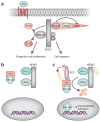Signal integration through blending, bolstering and bifurcating of intracellular information
- PMID: 20495562
- PMCID: PMC3086636
- DOI: 10.1038/nsmb.1843
Signal integration through blending, bolstering and bifurcating of intracellular information
Abstract
A cell's response to its environment is often determined by signaling through the actions of enzyme cascades. The ability to organize these enzymes into multiprotein complexes allows for a high degree of fidelity, efficiency and spatial precision in signaling responses.
Figures




References
-
- Saltiel AR, Kahn CR. Insulin signalling and the regulation of glucose and lipid metabolism. Nature. 2001;414:799–806. - PubMed
-
- Bers DM. Calcium cycling and signaling in cardiac myocytes. Annu Rev Physiol. 2008;70:23–49. - PubMed
-
- Millar JK, et al. Disruption of two novel genes by a translocation co-segregating with schizophrenia. Hum Mol Genet. 2000;9:1415–1423. - PubMed
-
- St Clair D, et al. Association within a family of a balanced autosomal translocation with major mental illness. Lancet. 1990;336:13–16. - PubMed
Publication types
MeSH terms
Substances
Grants and funding
LinkOut - more resources
Full Text Sources
Other Literature Sources

